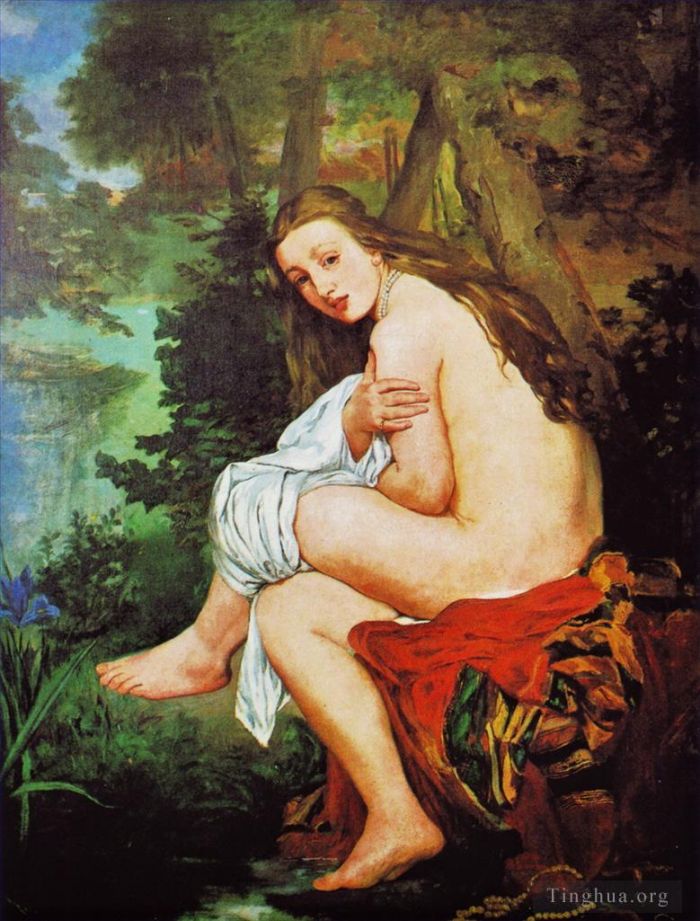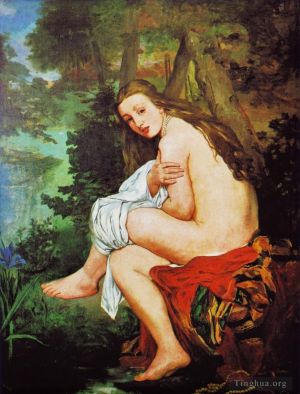Surprised Nymph
Edouard Manet
- Price: Price on Request
- Art Type: Oil Painting
- Size:
- English Comments: 0
- International Comments: 0
- Creating Date:
- Introduction and Works of Edouard Manet >>
Work Overview
- La Nymphe surprise (Nymph Surprised)
La Nymphe surprise
Artist Édouard Manet
Year 1861
Medium Oil on canvas
Dimensions 122 cm × 144 cm (48 in × 57 in)
Location National Museum of Fine Arts in Buenos Aires, Buenos Aires
La Nymphe surprise, or Nymph Surprised, is a painting by the French impressionist painter Édouard Manet, created in 1861. The model was Suzanne, a pianist and his secret beloved for years, whom he married two years later. The painting is a key work in Manet's production, marking the beginning of a new period in his artistic career and generally in the history of modernism in French painting. It is in National Museum of Fine Arts in Buenos Aires[1] and it is considered as one of the collection's highlights. Manet had special feelings for this painting, and La Nymphe surprise remained in the artist's possession his entire life, and there is evidence that points to the fact that, apart from the emotional significance it represented for the artist, Manet considered this painting as one of his most important works.
The model of the painting is Édouard Manet's lover, who also was his piano teacher, the Dutch girl Suzanne Leenhoff, with whom he had a secret love affair. This love affair developed while the young Manet was still living in his parents' house. The girl was three years older than the 17-year-old Manet and their relationship was kept secret from his family for a long time. Manet and Suzanne married after ten years of love relationship in 1863,[5] two years after the completion of this painting in 1861.[1] The relationship lasted throughout their lives.[5][6]
Nymphs were female spirits of nature, female deities from Greek mythology, often depicted as young women, who dwell in mountains and small woods, by springs and rivers.[7] Several authors think that the motif is similar to Rembrandt's Susanna and the Elders, considering that the model's name is Suzanne, she was Dutch and the figure's pose is identical with the one in the painting. Manet kept this painting in his atelier. The painting was exhibited at the Salon des Artistes Français in 1865.[2] This painting was painted two years before the Le Déjeuner sur l'herbe (The Luncheon on the Grass) and Olympia.[8] The painting was purchased by the National Museum of Fine Arts in Buenos Aires and was placed on display at the Museum, as one of the institution's highlights.
Manet's La Nymphe surprise depicts a young woman sitting in a wooded landscape beside a lake, looking surprised at the viewer. There is a blue iris growing at her feet, and she wears nothing on her body except the white pearls around her neck and a ring on her little finger. The nymph's glance, contrary to Olympia's provocative glance, is surprised and shy, as if she has found the viewer watching her, invading her privacy, disturbing her.
---------------------
Along with the Dejeuner sur I'herbe and Olympia, The Surprised Nymph is one of Manet's major treatments of the quintessential subject-matter of academic practice: the female nude. Like the two slightly later paintings, this is a large work and one which clearly took Manet some time to produce.
It is believed that the model for the painting was Suzanne Leen-hoff, Manet's future wife. In part, the work may be a pun on her name, for her pose is reminiscent of that of conventional depictions of Susannah disturbed by the elders, at once provocative and chaste. Around the time he produced this work, Manet moved into a new apartment on the rue de l'Hotel de Ville with Suzanne and Leon and the ambivalent attitude of the nude woman may suggest the artist's response to his future wife who in later paintings is shown as an upright member of the bourgeoisie. She is perhaps best understood in contrast to the nude woman in the Dejeuner for whom she represents both a prototype and a transformation. Whereas The Surprised Nymph depicts a naked bourgeois woman who shields her body from the gaze of the voyeuristic onlooker, she is presented in the Dejeuner as a professional working model apparently flaunts her body and subverts the traditional roles of the spectator and the nude.
- Copyright Statement:
All the reproduction of any forms about this work unauthorized by Singing Palette including images, texts and so on will be deemed to be violating the Copyright Laws.
To cite this webpage, please link back here.
- >> English Comments
- >> Chinese Comments
- >> French Comments
- >> German Comments
- >>Report
- Basket of Fruits
- The monk at prayer
- At Father Lathuille
- The Luncheon on the Grass (The Bath)
- The Grand Canal Venice
- Portrait of Emile Zola
- Portrait of Lina Campineanu
- Young Man in the Costume of a Majo
- The Bullfight
- Bench in autumn
- Victorine Meurent in the costume of an Espada
- Portrait of Zacharie Astruc
- Carnations and clematis in a crystal vase
- A boy with a pitcher
- Madame Brunet
- A matador
- On the Beach at Boulogne
- Reading Mme Manet and Leon
- Peaches
- The Kearsarge at Boulogne (Fishing boat coming in before the wind)
- Interior at Arcachon
- The ragpicker
- Woman in furs
- The model
- Madame Manet on a Blue Sofa
- Monet in his Studio Boat (Claude Monet Painting on His Boat-Studio in Argenteuil)
- Guitar and Hat
- The House at Rueil
- The Suicide
- Branch of White Peonies and Pruning Shears
- Jetty at Boulogne
- Portrait of Faure as Hamlet
- The Railway (Gare Saint-Lazare)
- Marguerite de Conflans Wearing Hood
- Theodore Duret
- Steamboat Leaving Boulogne
- Portrait of Gilbert Marcellin Desboutin
- Still Life Fruits on a Table
- The garden around Manet house
- Corner of a Café-Concert
- Boy with Dog
- Portrait of Mademoiselle Claus
- Young woman with a pink shoe
- Le Bon Bock A Good Glass of Beer
- Boy Blowing Bubbles
- Berthe Morisot with a Bouquet of Violets
- Portrait of Monsieur Brun
- Portrait of Emilie Ambre in the role of Carmen
- Effect of Snow at Petit Montrouge
- Vase of White Lilacs and Roses
- View of the 1867 Exposition Universelle
- Study of trees
- Moss Roses in a Vase
- Angelina
- Roses in a Champagne Glass
- Spring Study of Jeanne Demarsy
- The barque of Dante Copy after Delacroix
- The Street Singer
- Singer at a Cafe Concert
- Baudelaires Mistress Reclining Study of Jeanne Duval
- The Lemon
- Repose Study of
- A Game of Croquet
- Polichinelle
- Masked Ball at the Opera
- Bundle of Asparagus
- The Departure Of The Folkestone Boat
- The spanish ballet
- Argenteuil
- Plum
- At the Cafe
- Bench
- Gypsy with a Cigarette
- Rose and tulip
- Vase of Peonies on a Small Pedestal
- The Dead Christ with Angels
- Stephane Mallarme
- Nana
- Music in the Tuileries
- Christ with Angels
- Madame Manet in conservatory
- Swallows
- The Luncheon in the Studio
- Flowers in a Crystal Vase
- Madame Manet at the Piano
- Rochefort Escape
- The philosopher
- Still Life with Brioche
- Lola de Valence
- Bull fighting scene
- Portrait of Eva Gonzales
- Bouquet of flowers
- Eva Gonzales
- The Spanish Singer The Guitar Player
- Portrait of Mademoiselle Isabelle Lemonnier
- The Blonde with Bare Breasts
- The Waitress
- Woman with umbrella
- Young woman in the garden
- A Corner of the Garden in Rueil
- Madame Manet at Bellevue
- The Rest portrait of
- Woman Reading
- Bathers on the Seine
- Two Roses on a Tablecloth
- Le Chemin De Fer The Railroad
- The burial
- Execution of the Emperor Maximilian
- Embarkation after Folkestone
- Portrait of Henry Bernstein as a Child
- Head of a Dog
- The head of Christ
- Mother in the Garden at Bellevue
- Autumn Study of Mery Laurent
- The Races in the Bois de Boulogne
- Still life with melon and peaches
- Woman Before a Mirror
- Jesus Mocked by the Soldiers
- Flowers In A Crystal Vase flower Impressionism Edouard Manet
- The Port of Bordeaux
- A brioche
- Rue Mosnier decorated with Flags
- The Banks of the Seine at Argenteuil
- Lilac in a glass
- Woman Pouring Water Study of Suzanne Leenhoff
- The Monet family in their garden at Argenteuil
- View of Holland
- Portrait of Antonin Proust Realism Impressionism Edouard Manet
- Boating
- A King Charles Spanie
- Peonies in a vase
- The Horsewoman
- M and Mme Auguste Manet
- The conservatory
- Woman in a Tub
- A young man peeling a pear
- The Jetty at Boulogne
- Interior of a Cafe
- The ham
- On The Beach
- Pertuiset Lion Hunter
- The grand canal of Venice
- Oysters
- The Execution of the Emperor Maximilian of Mexico
- In the garden
- Portrait of Antonin Proust
- Victorine Meurent
- Young woman with a book
- Tarring the Boat
- Young woman in a round hat
- The Races at Longchamp
- The Milliner
- At the races
- The absinthe drinker
- Olympia
- Seascape at Berck Fishing Boats and Fishermen
- The old musician
- The Balcony
- Fishing
- Madame Auguste Manet
- The Boy with Cherries
- The Fifer
- Women at the Races
- Portrait of Suzanne Manet
- Surprised Nymph
- Portrait of Monsieur Tillet
- Almonds currants and peaches
- The stroll
- Young Woman in Oriental Garb
- Battle of Kearsage and Alabama
- The road menders Rue de Berne
- Woman with a Parrot
- Boy with a sword
- Eel and Red Mullet
- Woman with Fans (The Lady with Fans or Portrait of Nina de Callias)
- The Café-Concert (At the Café or The Bock Drinkers)
- The salmon
- Seascape at Arcachon
- The Garden at Bellevue
- The dead toreador
- Young Woman Reclining in Spanish Costume
- Young woman among the flowers
- Woman fastening her garter
- A Bar at the Folies-Bergère
- Bouquet Of Violets still life Impressionism Edouard Manet
- The Port of Bordeaux 2
- Head Of A Man
- Young woman in a negligee
- Portrait Of Mme Jules Guillemet
- On the Bench
- The Barricade Civil War









 Singing Palette
Singing Palette